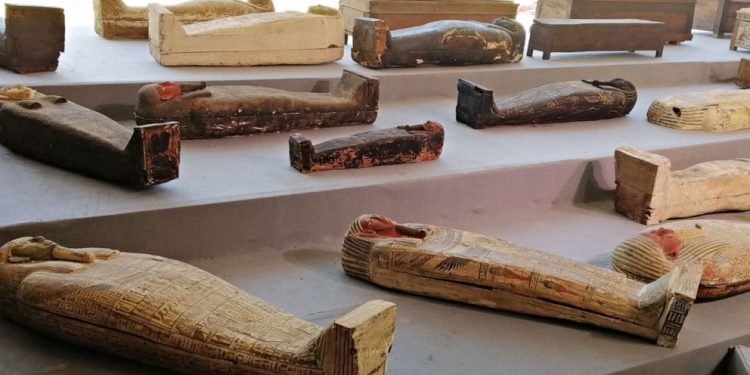The government of Egypt unearthed more than 100 sarcophagi in Saqqara on Saturday, the same ancient burial ground where dozens of coffins were also found last month as the country continues to make major discoveries in its bid to lure back tourists.
The coffins were exhumed from three burial shafts that are 12 meters deep, the head of Egypt’s Supreme Council of Antiquities Mostafa El-Waziri said, adding to the 59 sarcophagi discovered last month in the same area, which served as the necropolis for the ancient capital of Memphis, a UNESCO world heritage site.
“It’s the biggest discovery of 2020, but we are not stopping here yet. The discovery of one burial shaft leads to another,” antiquities minister Khaled El-Anany told reporters.
“Saqqara hasn’t yet revealed one percent of its secrets. We can find tombs and burial shafts in every single spot in this area.”
Some of the newly-uncovered coffins, which were colored and sealed, were displayed in a makeshift tent overlooking the Step pyramid of Djoser in the vast necropolis.
The gilded and wooden sarcophagi included mummies of priests and high-ranking officials belonging to the late and Ptolemaic periods, dating back more than 2,500 years ago.
El-Waziri said Egyptian missions were also stepping up their efforts to locate the workshop where the coffins were made. He attributed the discrepancy in the sarcophagi’s colors and shapes to the financial muscle of their owners, with some ability to pay for gilded coffins while others are only capable of paying for wooden ones.
Funerary masks and 40 wooden statues of Saqqara goddess Ptah Soker were also found in the burial shafts.
Egyptian archeologists performed a CT scan on one of the mummies during the announcement, saying the deceased had died in his 40s and that he didn’t suffer any chronic diseases.
Saqqara is home to 13 pyramids, including Djoser, which is deemed the oldest stone structure of its size in the world. A string of discoveries have been made there in the past few years, including the unearthing of a 4,400-year-old tomb of royal priest Wahtye in 2018 and the discovery of hundreds of mummified animals and statues a year later.
Egypt hopes its major discoveries will help revive its vital tourism industry, which took a fresh blow because of the COVID-19 pandemic just when it had begun to recover from the aftermath of uprisings and civil unrest in 2011 and 2013.



